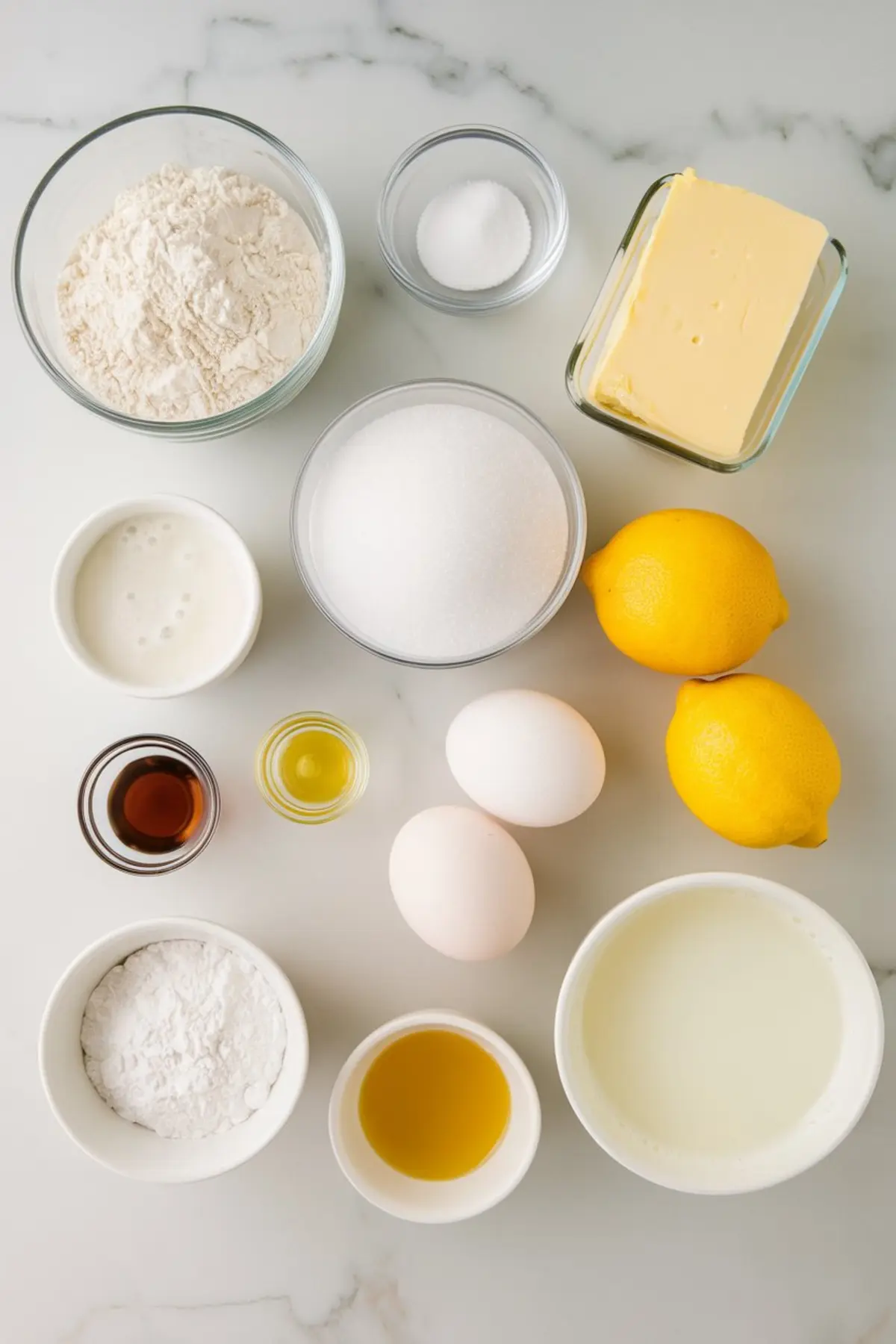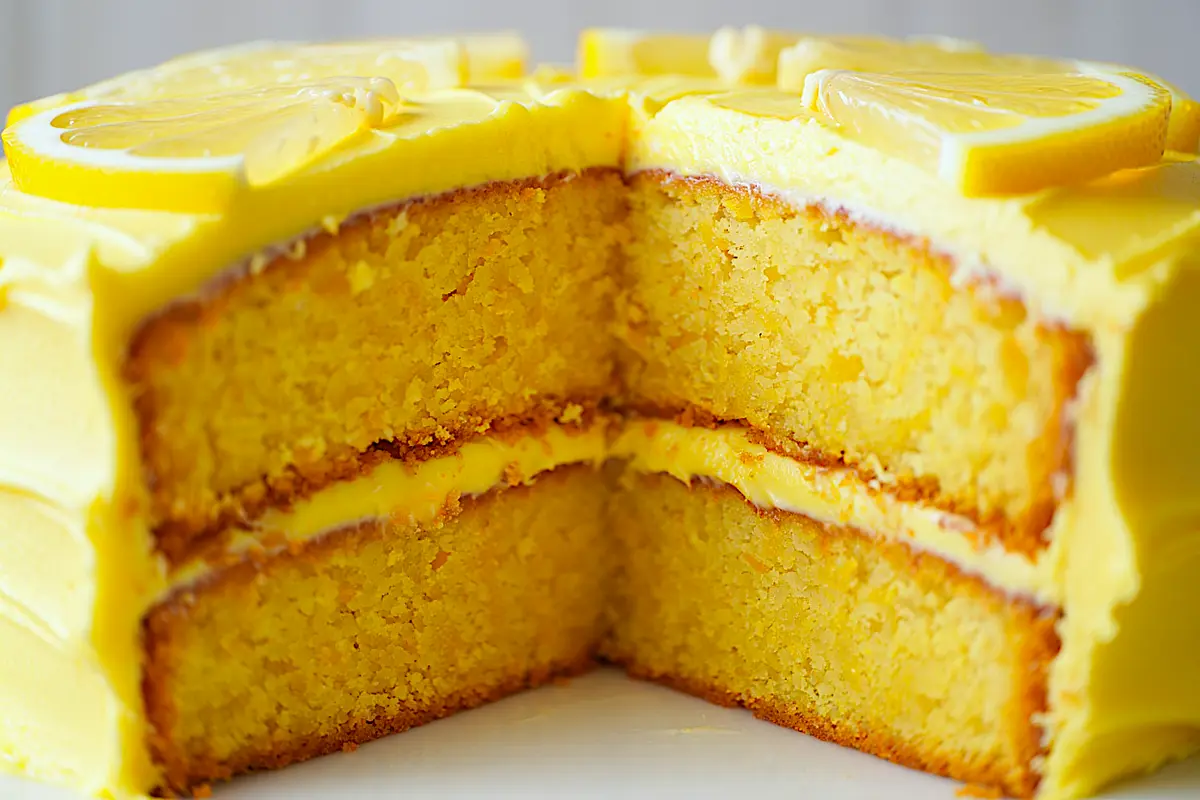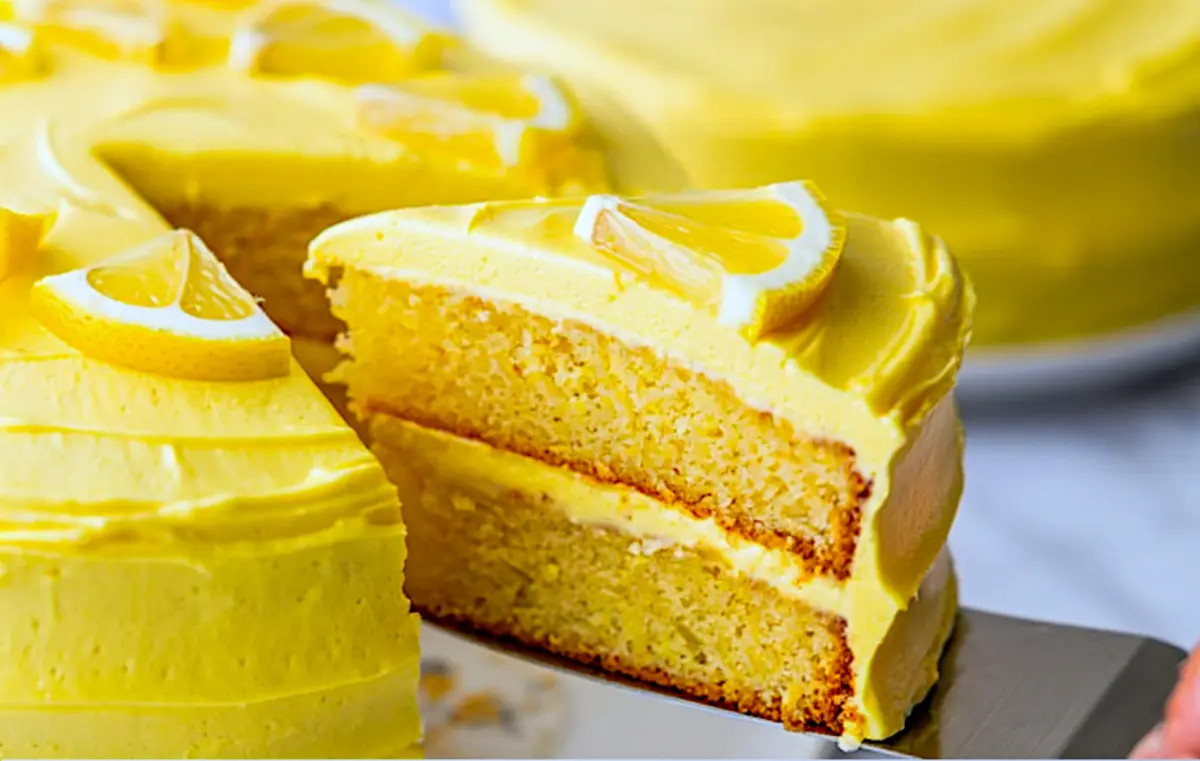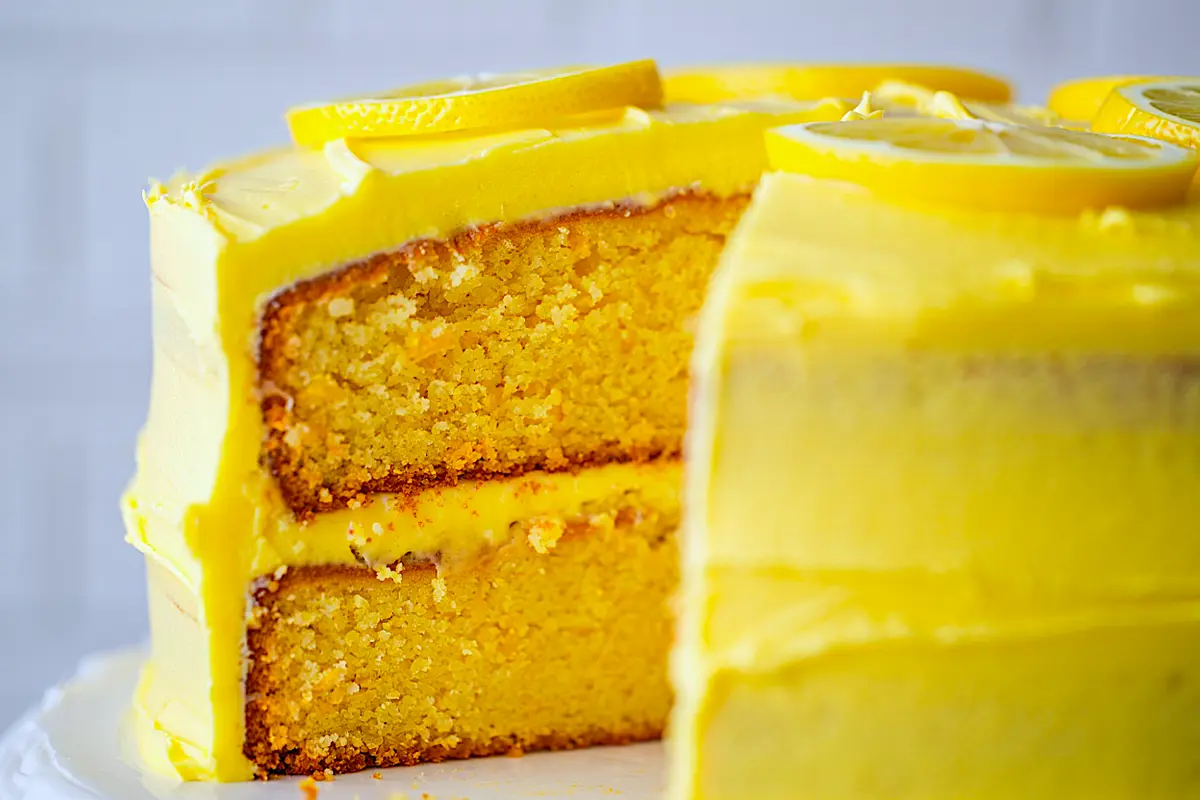If you’ve ever baked a lemon cake that looked the part but tasted flat, you’re not alone. Too many lemon cakes smell citrusy but fall short once sliced.
This one doesn’t.
You’ll learn how to make a lemon-forward cake that balances fresh juice, zest, and just enough fat to carry the flavor without dulling the edge. I’ve tested this cake in my kitchen more than a dozen times. I’ve compared oils, citrus types, and mixing methods. What you’ll find here is a result that holds together with clarity and structure, tender crumbn, bright buttercream, and a confident lemon presence in every bite.
This easy lemon cake from scratch uses fresh lemon juice and zest in both the batter and frosting, giving it real citrus impact.

How to Build a Lemon Cake That Tastes Like Actual Lemons
Start with butter and sugar—but don’t rush the creaming.
I always beat my butter, sugar, and lemon zest for at least three minutes. The zest needs time to press its oils into the butter. That’s what gives the cake its fragrant base before the lemon juice even comes in.

Once your mixture is light and pale, add the eggs one by one. Room temperature makes a difference here. Cold eggs won’t emulsify as evenly and can make the batter appear broken. Stir in vanilla last, after the eggs have done their work.
In another bowl, whisk flour with baking powder, baking soda, and salt. I sift these ingredients together to prevent clumps, especially since lemon juice can cause uneven rise if the leaveners aren’t well dispersed.

The wet ingredients—sour cream, milk, and lemon juice—should be whisked until smooth. I use full-fat sour cream and whole milk because they support the lemon without thinning the batter.
Then combine wet and dry ingredients gradually. I start and end with the flour mixture. This technique helps the structure hold, and it keeps the crumb from becoming rubbery. Mix on low speed. Stop as soon as you stop seeing flour streaks.
Fresh vs. Bottled Lemon Juice: Don’t Swap
I’ve tested both. Bottled juice flattens the flavor and adds an artificial edge. Fresh lemon juice gives the cake a clear, clean citrus profile. If you’re making a lemon cake from scratch, this choice matters more than you think.
The entire flavor of this cake depends on the juice and zest working together. Bottled juice simply doesn’t deliver.
If you’re using zest from fresh lemons anyway, squeeze the juice yourself. It takes one extra minute and changes everything.
If you’re looking for an oil-based lemon dessert, try my Lemon Blueberry Olive Oil Cake. The oil works well when fruit is baked into the batter. But with this plain lemon cake, where citrus has to stand on its own, butter gives better support.
How to Bake and Cool the Layers Without Drying Them Out

Grease and line two 8-inch pans. I use parchment on the bottom and a dusting of flour around the sides.
Divide the batter evenly between pans and smooth the tops. Bake at 350°F for about 30 to 35 minutes. Check around the 30-minute mark. A toothpick should come out with moist crumbs, not wet streaks.
Let the cakes cool in their pans for 10 minutes. Then transfer them to wire racks. This step prevents the bottoms from steaming and going soggy. Let them cool completely before you even think about frosting.
I bake this lemon layer cake in two pans to keep the structure simple and easy to frost.
Lemon Buttercream That Isn’t Overwhelming

This is not a frosting that screams.
It’s quiet, bright, and creamy. I use unsalted butter, powdered sugar, lemon zest, and fresh lemon juice. That’s it.
Start by beating the butter until it’s soft and fluffy. Add powdered sugar gradually, or you’ll end up wearing most of it. The lemon zest should be very fine. I often use a microplane and rub it into the sugar before mixing—it helps distribute the oils evenly.

The juice goes in last, a tablespoon at a time. Stop once the frosting holds its shape but still spreads easily.
This cake with lemon buttercream finishes with a spread that balances sweet and tart without overpowering the crumb.
You can add a touch of yellow food coloring if you want a brighter look, but I often leave mine natural. A pale, buttery yellow feels more honest.
Serving Notes and Storage Tips That Actually Matter

I serve this cake chilled for the first day. The crumb sets up beautifully in the fridge and slices cleanly. After that, I let it come to room temperature before serving. The flavor deepens slightly over time.
Store it covered on the counter for up to two days. If you’re keeping it longer, refrigerate it and let it sit out for 20 minutes before serving again.
You can bake the layers a day ahead. Wrap them tightly once cool. I’ve even frozen them for a week and thawed overnight in the fridge with no loss of texture.
Frosting can be made in advance and stored in the fridge. Bring it to room temperature and whip again before using.
For another lemon cake idea with more curd filling, try my Lemon Curd Cake or explore all my Lemon Desserts Recipes.
What Makes This Lemon Cake Stand Out? My Final Notes

This cake doesn’t hide behind sugar. It leads with lemon.
What makes a fresh lemon cake stand out isn’t just the juice—it’s how you layer the zest into each stage of the batter.
If you want something sharper, fill the center with curd. If you prefer something softer, pair it with berries. Either way, this is the kind of lemon cake that stands confidently on its own.

And if you’re looking for something cozier with a lemon twist, my Lemon Milk Bread adds a more subtle citrus note in a softer format.
If you’ve been looking for the best lemon cake recipe that actually delivers on flavor, this one holds its ground with clean layers and bright buttercream.
Pin this recipe so you can find it when citrus season hits—or save it for any day you need something bright but grounded.
Let me know in the comments how your cake turned out or what you’d change. I read every one.
Lemon Cake Recipe

A moist, lemon-forward cake made with fresh lemon zest and juice, layered with creamy lemon buttercream. This classic dessert is full of citrus flavor and has a light, tender crumb that pairs well with a bright, tangy frosting.
Ingredients
- FOR THE LEMON CAKE
- 2 ½ cups (315g) all-purpose flour
- 2 ½ tsp baking powder
- ½ tsp baking soda
- ½ tsp salt
- 1 cup (226g) unsalted butter, softened
- 1 ¾ cups (350g) granulated sugar
- Zest of 3 lemons
- 4 large eggs, room temperature
- 1 tsp vanilla extract
- ½ cup (120ml) sour cream
- ½ cup (120ml) whole milk
- ⅓ cup (80ml) fresh lemon juice
- FOR THE LEMON BUTTERCREAM
- 1 cup (226g) unsalted butter, softened
- 3 ½ cups (420g) powdered sugar
- 2 tbsp lemon zest
- 3–4 tbsp fresh lemon juice
- Pinch of salt
- Yellow gel food coloring (optional)
- GARNISH (OPTIONAL)
- Thin lemon slices
- Lemon zest curls
Instructions
- PREHEAT AND PREP: Preheat oven to 350°F (175°C). Grease and flour two 8-inch round cake pans or line the bottoms with parchment paper circles to prevent sticking.
- MIX THE DRY INGREDIENTS: In a medium bowl, whisk together flour, baking powder, baking soda, and salt. Set aside while preparing the wet ingredients.
- CREAM BUTTER, SUGAR & ZEST: In a large mixing bowl, beat the butter, sugar, and lemon zest on medium-high speed until light and fluffy, about 3–4 minutes. The lemon zest releases oils that infuse the batter with citrus aroma.
- ADD EGGS AND VANILLA: Beat in the eggs one at a time, mixing well after each addition to maintain an even texture. Stir in the vanilla extract until incorporated.
- COMBINE WET AND DRY: In a small bowl or measuring cup, whisk together sour cream, milk, and lemon juice. Add the dry ingredients to the butter mixture in three parts, alternating with the wet mixture, starting and ending with the dry. Mix on low speed just until combined; do not overmix.
- BAKE: Divide batter evenly between prepared pans and smooth the tops. Bake for 30–35 minutes or until a toothpick inserted into the center of the cakes comes out clean. Cool in pans for 10 minutes, then transfer to wire racks to cool completely before frosting.
- MAKE THE BUTTERCREAM: In a large bowl, beat softened butter until smooth and creamy. Gradually add powdered sugar, one cup at a time, beating well after each addition. Stir in lemon zest, lemon juice, and a pinch of salt. Continue beating until frosting is light and fluffy. Add yellow gel food coloring if a brighter color is desired.
- ASSEMBLE AND DECORATE: Place one cooled cake layer on a serving plate. Spread an even layer of lemon buttercream over the top. Add the second cake layer and frost the top and sides of the cake. Garnish with lemon slices or zest curls if using. Store covered at room temperature for up to 2 days or refrigerate for longer storage.
Notes
For best flavor, use freshly squeezed lemon juice and zest. Cake layers can be baked in advance and wrapped tightly in plastic wrap once cool. Frosting can be made ahead and stored in the refrigerator; bring to room temperature and re-whip before using.
Nutrition Information
Yield
12Serving Size
1Amount Per Serving Calories 219Total Fat 7gSaturated Fat 3gTrans Fat 0gUnsaturated Fat 3gCholesterol 77mgSodium 331mgCarbohydrates 36gFiber 2gSugar 10gProtein 6g

